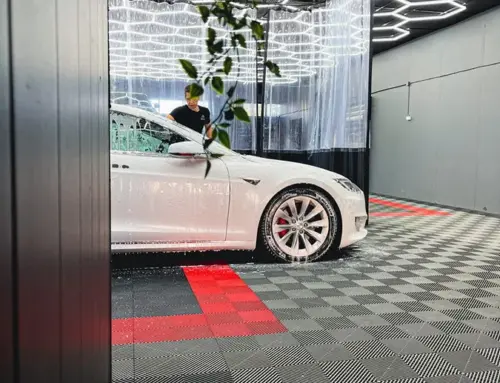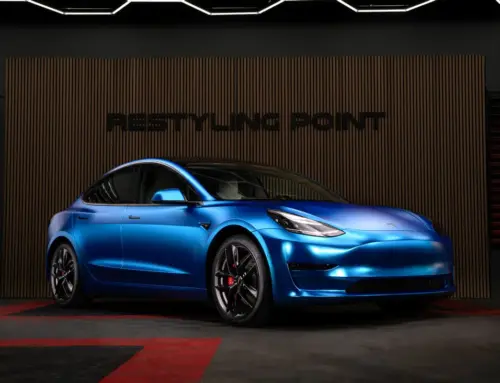Congratulations on your investment in your car’s resale value. To ensure that the product lasts as long as possible, it’s important to take care of it. By following the instructions, you’ll avoid risks.
After installation, do not wash the car for 2 weeks. If you notice any deficiencies/detachments/etc. in the installed product/service, please contact the installation shop in writing immediately.

Washing Instructions
The following warranty terms and washing instructions are significantly important for the customer and the durability of the performed service’s product.
We recommend familiarizing yourself with the following points and strictly adhering to the specified washing instructions.
1. We recommend only handwashing your car. Machine washing is at the customer’s own risk. The warranty is immediately void after the first machine wash.
2. When taking your car for handwashing, we recommend using the written washing instructions provided by Restyling Point. This ensures that you have provided the car wash with written instructions, and if anything happens to the tapes/films, the car wash will be responsible if the car is washed against the instructions.
3. If the pressure from the pressure washer comes too close during the washing process, it may lift the film/tape from the edge or create a hole in a flat area. Therefore, machine washes are at your own risk, and we recommend handwashing the car.

4. Direction of pressure washer: not towards the edges. Pressure directed towards the edges can loosen the tape, making it impossible to reattach, rendering that area unusable.
5. Seagull droppings contain a strong chemical that corrodes even the paint surface, not to mention the tape/PPF surface. Therefore, we recommend wiping off the droppings from the surface as soon as possible, even with a damp cloth.
6. Regular washing is important for maintaining the surface: in winter, it’s good to wash the car regularly using iron and tar remover. In summer, we recommend thoroughly cleaning the front from insects to avoid having to polish them off. For example, in satin and matte tapes, the polishing process makes the surface shiny. Washing instructions for matte finish cars.
7. The secret to the right and effective car wash process is not high pressure but effective, safe, tested, and high-quality chemicals. Check the effectiveness of the chemicals from the chemical manufacturer or a professional shop knowledgeable about them. There are specific chemicals for each type of dirt, such as iron remover, tar remover, insect remover, etc. For example, you can get efficient professional products from us for easy car washing.
8. If you’re applying aftermarket waxes/ceramic coatings, we recommend testing them first in a small inconspicuous area. If you apply waxes to a matte surface, it will make the surface shiny, and wax removal may be challenging.
9. Glossy PPF films contain a natural water-repellent surface called TopCoat, so they may repel ceramic coatings.
10. Washing is recommended in a covered area. Dark-colored cars should be allowed to cool down before washing in hot weather.
11. Do not wash in direct sunlight, high risk of chemicals burning onto the surface.
12. Drying is recommended with a cloth, not a rubber squeegee.
13. Leaving the car wet poses a risk of water droplets drying on the surface, causing lime spots.
Warranty Terms
It’s important to check the warranty terms if any questions arise regarding the durability of the film.

Tips and Features:
– If a stone impact hits the edge of the film/tape, its adhesive surface may weaken (refer to the installation warranty terms).
– If the car had a ceramic coating before the installation of the PPF film/tape, it may significantly reduce the adhesive’s adhesion, even if the ceramic coating removal process or polishing has been done. This is because during the application of the ceramic coating, the substance may penetrate into cracks and edges, making the coating removal extremely difficult and in some places even impossible.
– If any part of the car’s body (usually, for example, the lower part of the front/rear bumper, side lower sill, etc.) comes into contact with snow, the ground, an obstacle, etc., the film/tape attached to it may be damaged.
– If a large stone or nail hits a flat area, it will likely cause a visual change in the film/tape in the form of a stone impact or another chemical reaction. With a large stone impact, the stone may chip off a small piece of the tape from the tape/PPF film.
– Sunlight UV radiation may wear out dark tape colors more than light ones, possibly causing pigment fading. This is a normal phenomenon because dark colors absorb heat significantly more than lighter colors. In this case, tape fading is a normal phenomenon.
– Too tight and abrasive seals/body parts/handles, etc., due to constant movement of the car body/car usage, may cause friction on the PPF film/overtaping tape, forming a wrinkled or stressed area, which is natural wear and tear.
– When scraping ice off the windows in winter, care must be taken not to hit the scraper against the window seals/paint surface, which may damage the aforementioned.
– If you have insurance, make sure that if a repair is needed, the repainted part should not be taped or coated for at least 4-6 weeks after painting. Otherwise, the paint simply won’t adhere to the body part.
– Based on our experience, compensation for PPF protective film in insurance cases usually comes from the liability insurance of another party (the at-fault party in a traffic accident). Each customer must ensure this with their insurance company. However, according to the accounts of our customers, some insurance companies cover protective film within their compensation scope for self-inflicted damage. Therefore, it is advisable to confirm with your insurance company whether PPF protective film is included in your insurance conditions in cases of self-inflicted damage, vandalism, or similar incidents.
– Snow freezing on top of the car may cause stress on the exposed edges of the PPF film/tape.
– The strongest sun radiation stress is directed to horizontal surfaces, such as the roof, hood, and trunk lid. Materials withstand best in completely vertical surfaces, such as doors.
Removal of Tapes/Films:
The tape manufacturers we use have been carefully selected and tested over the years to ensure that they are easy and safe to remove. If the tape/PPF film is removed outside the manufacturer’s warranty period, the consequences are at your own risk. If the tape/film has been on for too long, it may come off in small pieces, which prolongs the removal process.
Removal of PPF films and tapes is generally recommended only in a professional shop. In the world, everything can be done by oneself, including tape removal, so if you decide to remove the tape yourself, adhere to the following guidelines:
Tape removal is entirely at your own risk if you do it yourself.
Removal of overtaping tape: Carefully apply heat with a heat gun, and the tape will peel off with its adhesives.
Removal of PPF film: PPF film usually comes off best without heat. The tape should not be removed by pulling it so that there is approximately a 180° angle between the removed PPF’s adhesive surface and the paint surface. This is the most common and natural pulling method, which is incorrect.
However, the safe and correct way is to remove the PPF by lifting it from below the adhesive surface or by pulling it away from the adhesive PPF piece to be removed.

From the area. Thus, there is a 45° angle between the adhesive surface and the paint surface.
Edges of tapes and PPF films must be carefully removed, pulling them away from the surface towards the edges. Typically, there is less paint thickness at the edges of the body parts, so the paint comes off more easily from there than from the flat surface in the middle, especially if it’s a low-quality paint job.
If there are adhesive residues left from the PPF film, they can be removed with safe adhesive removers.
General
Some customers who bring their cars to Restyling Point’s premises notice things about their cars that they hadn’t noticed before. The reason for this is the excellent lighting, the cleanliness of the car, and its showroom condition, which it may not have been in before. This triggers a cognitive natural reaction: when a customer pays for a service, they scrutinize the work done very closely, almost through a magnifying glass, and in doing so, they also notice things they didn’t know were there or hadn’t noticed before. At this point, people are more thorough in their inspection than in their daily use of the car.
Restyling Point’s operating model is honest and straightforward: if something happens, the customer does not need to point it out to us because we have already informed the customer first. So, whether the customer notices something or not, they will still be informed if something has happened. We do not inform the customer about scratches and paint damage found in the car during the process because even new cars often have many of them. We only inform about things that significantly affect the cost of the process or are very unusual, such as:
- In a brand new Porsche with only 100 km driven and costing 150,000 €, there was a 60 cm long and very deep scratch on the front fender that had been attempted to be polished (the edges of the scratch were rounded) & (the polishing compounds were not wiped off from the engine compartment side), and the customer was not aware of this, and the front fender was supposed to be protected with film, but we stopped the film application on the front fender because it required repainting. The customer was not aware of the scratch.

- In a brand new Tesla Model Y with only 5 km driven, there was a water-sanded unfinished finish visible under the factory PPF protection on the rear door. It appeared that debris had been sanded away from inside the paint surface, leaving visible marks.

- The customer opted for a Full Front protection film installation, and when we began working on the front bumper as the last step, we noticed that the front bumper had significantly more deep stone chips compared to the rest of the paint surface. We informed the customer that we would halt the process at the front bumper and recommended repainting it before applying the protection film. The customer appreciated this attention to detail. We always consider the practicality and cost-effectiveness from the customer’s perspective and do not greedily prioritize revenue.

Would you like the work to be done responsibly, on schedule, and with the best value for your money? Ask for a quote from the professionals at Restyling Point, who perform their work with quality standards, values, and love.
On WhatsApp: +358445050624
Phone: +358445050624
By Email: [email protected]
Restyling Point Oy – Leading in wrapping and protection treatments in the Nordics











